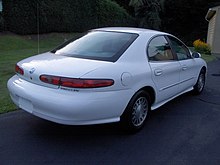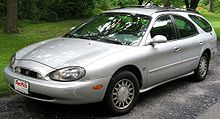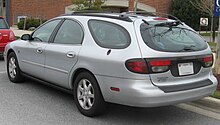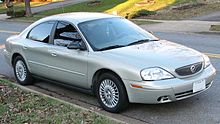Mercury Sable
| Mercury Sable | |
|---|---|
| Production period: | 1986-2009 |
| Class : | upper middle class |
| Body versions : | Limousine , station wagon |
| Previous model: | Mercury Marquis , Mercury Montego |
| Successor: | Mercury Montego |
The Mercury Sable was a car model produced by the US American brand Mercury , which was part of the Ford Group, and was produced from 1986 to 2009 . The Sable was based on the largely identical Ford Taurus . In the meantime, from 2005 to 2007, it was replaced by the Mercury Montego , but after a fundamental revision for the 2008 model year it was sold again under the name Sable. Production of the Sable was stopped on May 21, 2009.
Sable (1986-1991)
| 1st generation | |
|---|---|
|
Mercury Sable Sedan (1986-1991) |
|
| Production period: | 1986-1991 |
| Body versions : | Limousine , station wagon |
| Engines: |
Gasoline engines : 2.5-3.8 liters (65-104 kW) |
| Length: | 4849-4874 mm |
| Width: | 1796 mm |
| Height: | 1377-1400 mm |
| Wheelbase : | 2692 mm |
| Empty weight : | 1274-1525 kg |
Christmas 1985 presents Mercury as a successor to the Mercury Marquis the very modern, aerodynamically designed and futuristic Sable with front wheel drive, which is characterized by a c w value distinguished of 0.29. In the first model year, customers had the choice between a 66 kW (90 PS) HSC four-cylinder in combination with a three-speed automatic or a 104 kW 3.0-liter Vulcan V6 coupled with a four-speed automatic. The V6 engine turned out to be the more popular and successful variant. The sales of the four-cylinder models were so disappointing that these versions were withdrawn from the range in 1987 (they were still available for the Taurus until 1991). Ford's 3.8 liter Essex V6 was added to the engine range in 1988.
Despite the identical output of 104 kW (141 hp) to the Vulcan V6, the Essex had, thanks to its larger displacement, a higher torque of 291 Nm, which was particularly welcome in the heavier station wagon variants. However, the Essex 3.8 suffered from reliability problems with the cylinder head gaskets. There were also cooling problems.
Over the years the Sable has only seen minor modifications, mainly in the areas of equipment and design.
In the fall of 1991, after sales had dropped to just under 90,000 copies, the second generation of the Sable was introduced.
Sable (1991-1995)
| 2nd generation | |
|---|---|
|
Mercury Sable Sedan (1991-1995) |
|
| Production period: | 1991-1995 |
| Body versions : | Limousine , station wagon |
| Engines: |
Petrol engines : 3.0-3.8 liters (101-104 kW) |
| Length: | 4882-4910 mm |
| Width: | 1808 mm |
| Height: | 1374-1410 mm |
| Wheelbase : | 2692 mm |
| Empty weight : | 1414-1525 kg |
The Sable received its first extensive body modifications in autumn 1991. In addition to the front and rear, the interior was also modernized, for which Ford invested $ 650 million. The new model brought it back to 103,000 units sold in 1992, despite the last weak sales figures of the predecessor. Although the design language remained largely unchanged, every body part except the roof had been redesigned. The redesigned interior was optionally available with side airbags, a novelty in the middle class at the time.
In 1993, unpopular extras such as the InstaClear heated windshield were removed from the range. A passenger side airbag was part of the basic equipment from 1993, the driver airbag was revised and the steering wheel modified in 1994.
The station wagon version of the Sable was mostly available with the same options as the sedan. The station wagon models had a trunk volume of up to 2294 liters with the rear bench seat folded down. If this was set up (divisible in a 60/40 ratio), the trunk still held 1274 liters.
The station wagon also had a separately hinged rear window and roof rails, an optional third row of seats facing the direction of travel, a lockable compartment in the underbody and an optional pull-out picnic table. Kombi models with a continuous bench in the front and an additional third row of seats could carry up to eight people.
The last year of production of the second model generation was 1995. The LTS equipment line was added to the range for this model year. It offered leather seats, light alloy wheels taken over from the Taurus LX, special plastic paneling on the body and partial leather interior. The LTS was available with the three-liter Vulcan engine as standard, or with the 3.8-liter Essex engine on request.
A total of 1,090,450 copies of the first and second generation Sable were produced in 10 years.
Sable (1995-1999)
| 3rd generation | |
|---|---|
|
Mercury Sable Sedan (1995-1999) |
|
| Production period: | 1995-1999 |
| Body versions : | Limousine , station wagon |
| Engines: |
Petrol engines : 3.0 liters (108–149 kW) |
| Length: | 5017 mm |
| Width: | 1854 mm |
| Height: | 1400 mm |
| Wheelbase : | 2743 mm |
| Empty weight : | 1494-1601 kg |
In the fall of 1995, Mercury brought out a completely redesigned model. After only slight cosmetic revisions had been made to the style of the second model generation, Ford hoped to be able to achieve similar successes with the radical design of the third generation as with the Sable introduced in 1986. However, the controversial oval design language was not well received by the press and the public and was subsequently seen as the reason for the poor sales figures.
With this generation of models, attempts were made to position the Sable "higher" and to integrate it closer to the luxury segment, which also led to a considerable increase in prices and, as a result, to loss of customers. The 1996 Sable was the first model to share body panels with the Ford Taurus. The main differences between the two were the different front and rear sections. Although the design of the Sable was less characterized by the controversial oval shape elements, sales fell.
The 96 Sable could be ordered with a 3.0 liter Duratec 30 V6 with double overhead camshafts and 149 kW (203 hp) output. The equipment lines remained the same, with the GS as the basic model and the LS as the luxury variant. The LTS was no longer offered.
While the 3.0 Duratec engine was available as an option for all models from 1998, it was reserved for the LS from model year 1999. In the 1999 model year, single front seats were also available as an option for the GS version. Also in 1999 the performance of the 2000 Duratec was increased in the hope of increasing sales.
To counteract the declining sales of the Sable, Mercury tried to reduce production costs. The Sable got a new, cheaper front section in 1998, which reduced the 1999 sales price by up to $ 2000. In addition, some equipment options have been deleted, which led to further savings.
Sable (1999-2005)
| 4th generation | |
|---|---|
|
Mercury Sable Sedan (1999-2003) |
|
| Production period: | 1999-2005 |
| Body versions : | Limousine , station wagon |
| Engines: |
Petrol engines : 3.0 liters (115–149 kW) |
| Length: | 5024-5075 mm |
| Width: | 1854 mm |
| Height: | 1410-1468 mm |
| Wheelbase : | 2743 mm |
| Empty weight : | |
The Sable received another facelift at the end of 1999, during which the oval design shapes were weakened. With the new design, the vehicle also received a higher roofline above the rear, which provided both more headroom and increased trunk volume. The interior has been completely redesigned in a less polarizing, much more conventional design language. The chassis has been tuned to be even softer in order to meet the needs of a wider, less sporty customer base. To reduce manufacturing costs, some of the features of the predecessor, such as four-wheel disc brakes, were omitted.
The 2002 Sable had more extensive equipment in every level, including an audio system with CD player and an electrically adjustable driver's seat in the GS version, an electric sunroof and leather interior in the LS version. Side airbags and traction control were now available as extras for all models.
In autumn 2003, the Sable underwent minor cosmetic changes to the front, in particular in the form of a new chrome grille, and modifications in the rear. In the interior, the instruments and the steering wheel have been redesigned.
Since the Mercury brand was no longer offered in Canada, the fourth generation of the Sable was no longer available there and was only sold in the USA and Mexico.
The Mercury Montego (2004) and the Mercury Milan (2005) were presented as successors to the Sable . Shortly after the introduction of the Montego, the Sable was discontinued, at the same time as the Taurus station wagon. The Taurus continued to be produced initially as a sedan for major customers. The last Sable left the Atlanta manufacturing facility on April 29, 2005.
Sable (2007-2009)
| 5th generation | |
|---|---|
|
Mercury Sable Sedan (2007-2009) |
|
| Production period: | 2007-2009 |
| Body versions : | limousine |
| Engines: |
Otto engine : 3.5 liters (196 kW) |
| Length: | 5133 mm |
| Width: | 1892 mm |
| Height: | 1562 mm |
| Wheelbase : | 2868 mm |
| Empty weight : | 1652-1730 kg |
In retrospect , Alan Mulally, CEO of Ford, described the idea of giving new models a name that begins with F in the case of Ford or with M in the case of Mercury , as a bad marketing strategy, because it means many traditional names like Taurus and Sable would have been lost. Mulally therefore decided to revive some traditional names. This also includes the name "Sable", as the Montego has been called again since the beginning of the 2008 model year. It was hoped that the familiar name would attract more buyers again.
The facelift in autumn 2007, which was accompanied by the name change, included a new front section and headlights based on those of the Mercury Milan . There were also exterior mirrors and door handles in an aluminum look and new LED taillights. The range of engines was supplemented by the Ford Edge's 3.5-liter Cyclone V6 with 196 kW and a torque of 337 Nm. Power was transmitted via a 6F six-speed automatic from Ford.
However, the actual sales figures still fell short of expectations. With the model change in the Ford Taurus, production of the Sable ended in May 2009 without a successor.
Special models
There were some very rare special models of the first generation Sable.
In 1987 a special version called the LS Monochrome Edition was offered in which the bumpers, side skirts and the rims were painted white. This model was only offered in 1987; the production number is not known.
A 50th Anniversary Version was launched on the occasion of the 50th birthday of the Mercury brand in 1989, of which only 50 were sold. Mercury was planning a sporty luxury version of the Sable with the designation LTS. This luxury sport variant should be based on the Ford Taurus SHO (Super High Output) with a V8 engine. The idea was dropped in order not to create unnecessary competition to the Taurus SHO. In 1994 a Sable LTS was brought onto the market, but not as a sporty top model, but only as a particularly well-equipped LS version.
A special one-off, a Sable convertible, was built in 1988 for the SAE auto show in Detroit. It was based on an ordinary Sable sedan, but had a separate two-door body with a folding roof. However, the concept was not pursued further and not developed to market maturity. The only Sable convertible ever built stood in a warehouse for years before it received a type number and approval. It was auctioned on eBay in 2006.
Awards
The Sable was included three times on the annual list of the ten best cars by the US car magazine Car and Driver , first in its publication year 1986 and then in 1990 and 1991.
swell
- Flammang, James M. and Kowalke, Ron: Standard Catalog of American Cars 1976-1999 , Krause Publication, Iola 1999, ISBN 0-87341-755-0 , pp. 666-697.
Individual evidence
- ↑ Flammang / Kowalke, Standard Catalog of American Cars 1976-1999, p. 667
Web links
- Taurus Car Club of America (English)











